The Importance of Swimming Booties and Gloves in Kiteboarding
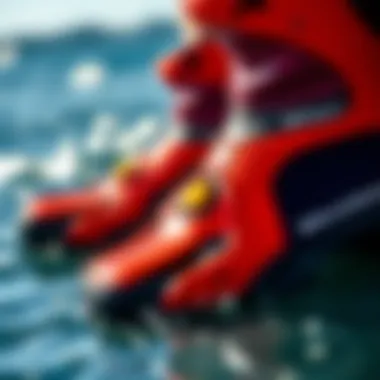
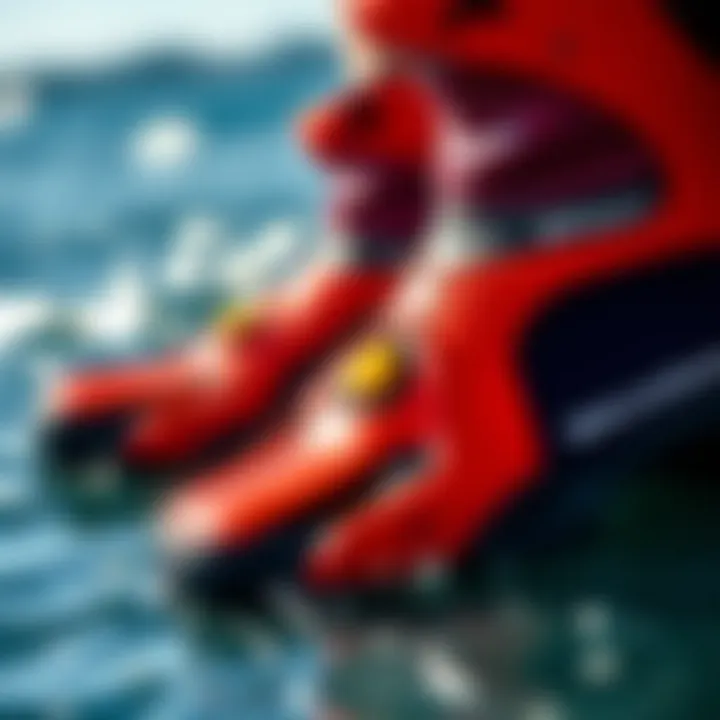
Intro
Kiteboarding is not just a sport; it's an adventure that pushes the limits of both physical ability and mental resilience. As you skim across the water, the thrill of the wind and waves dances around you. But, like any outdoor activity, it comes with its own set of challenges. One often overlooked aspect is the right gear, specifically swimming booties and gloves, which play a crucial role in enhancing both performance and safety.
In this article, we’ll dive deep into how these accessories can transform your kiteboarding experience, from providing necessary grip and protection to allowing for better water maneuverability. You'll learn about the materials that matter, how to select the right design, and how these items can help you navigate the environmental hurdles kiteboarders encounter.
A well-informed kiteboarder is a safer kiteboarder. Whether you're a newcomer or a seasoned rider hitting the waves, understanding the significance of swimming booties and gloves can help refine your setup and prepare you for everything the water throws your way. Let’s kick things off with the gear you need to get started.
Gear and Equipment
When it comes to kiteboarding, the right equipment can make a world of difference. Not only does it improve performance, but it also enhances safety, allowing riders to tackle various conditions with confidence. This section explores essential gear for beginners as well as advanced options for experienced riders.
Essential Kiteboarding Gear for Beginners
If you’re just dipping your toes into the kiteboarding waters, investing in quality gear is paramount. Here’s a look at the essentials:
- Kite: A larger kite that's appropriate for your wind conditions will be your first piece of kit. Look for brands like Duotone or Cabrinha as a starting point.
- Board: A twin-tip board gives you versatility as you learn how to ride in both directions.
- Harness: This is what connects you to the kite. Opt for a seat harness if you're looking for more support during those initial maneuvers.
- Swimming Booties: This is where we start to dig deep. You’ll need something that provides decent grip for steering the board while protecting your feet from sharp objects underwater.
- Gloves: These will give you a better grip on the control bar and offer some protection against the elements.
Advanced Equipment for Experienced Riders
Once you've got the basics down, there are several advanced items to consider:
- High-Performance Kites: As your skills develop, you’ll want to look into kites that can handle extreme speeds and maneuvers.
- Directional Boards or Surfboards: For those who wish to tackle waves, this will allow for more fluid navigation.
- Impact Vests: These provide additional safety should you fall hard. It's like having a little insurance while you boost off waves.
- Specialized Booties: Consider neoprene booties designed specifically for water sports that enhance foot grip and warmth.
- Wind-Resistant Gloves: Look for gloves that also provide good dexterity; you don’t want your grip weakened just because they’re warm.
"When it comes to kiteboarding, having the right gear is like having your seatbelt fastened; it keeps you safe while allowing you to enjoy the ride.”
Understanding your gear and making informed choices is key to having a successful kiteboarding adventure. Now that we’ve covered gear, let's explore the techniques and tips to further improve your skills.
Techniques and Tips
Techniques and safe practices can elevate your kiteboarding abilities significantly. Whether you’re a newbie refining your skills or an expert perfecting your craft, there’s always room for improvement in this dynamic sport.
Safety Practices for Kiteboarding
Safety should be your top priority. Here are some best practices to keep in mind:
- Kite Control: Always keep an eye on the kite positioning as it affects your balance and can prevent sudden downwind drift.
- Weather Knowledge: Familiarize yourself with the local weather patterns to avoid storms or high winds that can quickly become dangerous.
- Buddy System: Whenever possible, never kite alone. Having someone to help in case of trouble can be invaluable.
- Emergency Procedures: Invest time in understanding the quick release mechanisms on your harness and how to use them in emergencies.
Training Techniques to Improve Your Skills
Practice remains king in mastering kiteboarding. Here are some techniques that can aid your journey:
- Drills on Land: Practice your movements and kite control on land before hitting the water. This helps in building muscle memory.
- Video Analysis: Recording your sessions can provide invaluable feedback. You might find you’re making the same mistakes repeatedly.
- Workshops or Classes: Enrolling in advanced kiteboarding classes can offer tailored feedback from professionals.
As kiteboarding is a sport that marries skill with nature, it’s essential to remain adaptable. Your gear plays a crucial role in success, with swimming booties and gloves being key components that keep you grounded, safe, and ready to take on the wind and water.
Through knowledge and preparation, each kiteboarder can enhance their experience, ensuring that every outing is not just a ride, but an adventure.
Prolusion to Kiteboarding Gear
Kiteboarding is increasingly recognized as an exhilarating blend of surfing and flying, where riders harness the power of the wind with a kite while gliding over water on a board. Understanding the right gear for this demanding sport can significantly impact your safety, performance, and overall enjoyment. In this aspect, we’re going to shed light on some indispensable accessories, namely swimming booties and gloves, their roles, specifications, and the numerous benefits they provide.
While many jump into kiteboarding with just a kite and a board, seasoned adventurers know better. Choosing the right accessories can be the difference between a perfect day and a disaster. Without adequate gear, you might find yourself dealing with cold water, painful scrapes, or even injury—those scenarios can dampen anyone's spirits. The right accessories not only enhance your overall experience but also safeguard against the botches and bruises that can come with the territory.
Importance of the Right Accessories
In the thrilling world of kiteboarding, it turns out that what you wear is as critical as how you ride. Booties and gloves might not seem like the first things that pop into your head when you think of gear, but they play vital roles in improving comfort, dexterity, and safety.
- Protection from Elements: Exposure to cold water can sap your energy and enjoyment. Booties provide insulation, allowing you to focus on the thrill without the distraction of numb feet.
- Enhanced Grip: Gloves designed for kiteboarding are crafted to offer the right balance of flexibility and grip. Because a good grip can be the game-changer when controlling the kite.
- Safety Net: Both gloves and booties serve as protective barriers against sharp objects lurking beneath the water, like rocks or marine life.
In essence, the right accessories elevate your kiteboarding experience. They help you stay safe and ensure that you can perform at your best, even as conditions become challenging.
Overview of Common Gear
So, what does the gear landscape look like for kiteboarding? Beyond the kite and board, there are several other essential tools that kiteboarders should have in their arsenal. Common gear includes:
- Kite: The heart of the sport, responsible for harnessing wind energy.
- Board: A platform for riding, which varies in design depending on skill level and riding style.
- Harness: Connects the rider to the kite, allowing for the transfer of force when pulling.
- Safety Leash: An essential safety measure that keeps the kite controlled in case of an emergency.
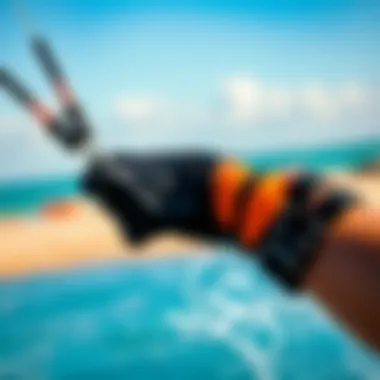
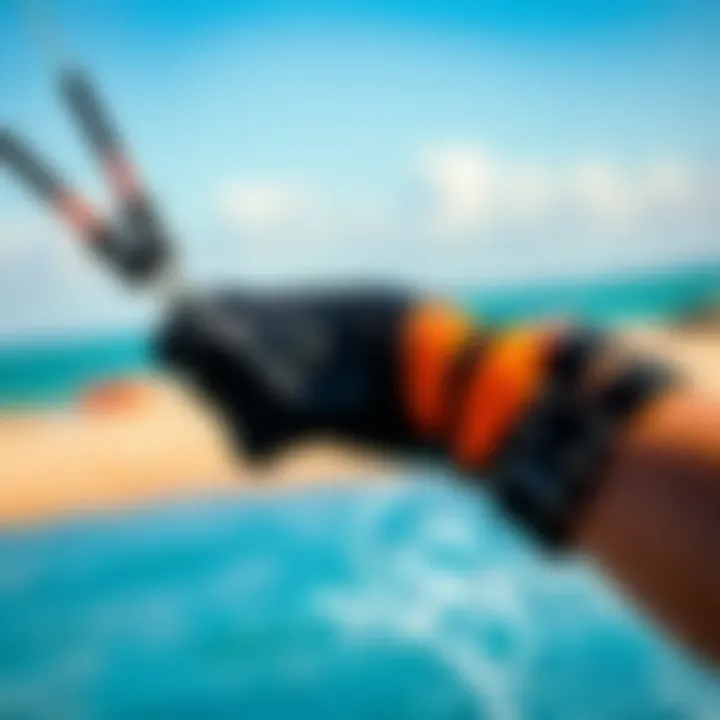
In addition to these, swimming booties and gloves, as discussed, are vital accessories that ensure comfort and improve safety. As we'll explore later, they're designed specifically for kiteboarding in a way that takes into account the unique demands of the sport.
As kiteboarding continues to gain popularity, keeping informed about the best gear not only enhances your skill set but also shapes your adventures on the water. It's about preparing for the ride of your life.
Understanding Swimming Booties
In the realm of kiteboarding, swimming booties often don’t get the spotlight they deserve. They’re not just a nice-to-have accessory; they play a crucial role in your overall experience on the water. By providing essential protection, comfort, and grip, they can make a world of difference in how you handle your board, navigate through different conditions, and avoid injuries, especially when launching from rocky shores or when catching waves.
Definition and Purpose
Swimming booties are specialized footwear designed for water sports like kiteboarding, surfing, and diving. These booties offer a snug fit and are typically made from flexible materials that allow for easy movement and dexterity.
Their primary purposes include:
- Protection: They shield your feet from sharp rocks, coral, or other hidden hazards under the water.
- Thermal Insulation: Depending on the material, they can keep your feet warm in chillier waters, enhancing your comfort during extended sessions.
- Improved Grip: A well-designed bootie provides a firm grip on your board, allowing for better control when navigating tricky waves or gusty winds.
Materials Used in Booties
When it comes to the materials used in swimming booties, there are several options available, each with its own set of advantages and disadvantages. Understanding these can help you choose a pair that best fits your kiteboarding needs.
Neoprene Advantages
Neoprene remains a popular choice for swimming booties because of its unique properties.
Key characteristics of neoprene include:
- Insulation: This material traps heat effectively, ensuring your feet stay warm in cooler waters.
- Flexibility: Neoprene provides excellent mobility, allowing for a natural foot movement, which is essential for balancing on your board.
- Durability: Neoprene is sturdy and resistant to wear and tear, making it suitable for rigorous sports activities.
The combination of warmth and flexibility makes these booties a strong contender for kiteboarders braving cooler climates. However, one should be cautious; neoprene can retain water, which could lead to a heavier feeling if you’re not careful.
Alternative Materials Considerations
While neoprene is widely recognized, there are also alternative materials that can offer different benefits.
Key aspects include:
- Mesh Fabrics: These are lighter and provide excellent drainage, which is useful for warmer conditions where water retention could be an issue.
- Synthetic Blends: Some booties are made with a mix of materials designed to combine the best of neoprene and mesh, providing both insulation and breathability.
Each material has its own balance of benefits. For instance, while mesh might be better for drainage, it may not provide the same level of warmth as neoprene during chilly sessions.
Types of Swimming Booties
The market offers several varieties of swimming booties tailored specifically for different water sports, including kiteboarding.
Dive Booties
Dive booties are designed primarily for underwater activities, focusing on insulation and a snug fit to prevent water from seeping in.
Key characteristic: Their thicker sole provides extra padding, making them effective for those who might encounter sharp objects underwater. However, they may not have the same grip or flexibility needed for kiteboarding, potentially limiting agility.
Surf Booties
Surf booties usually have a thinner profile and are optimized for grip.
Key attributes: They often are designed with a more flexible sole and a snug fit, allowing for excellent board feel, essential during tricky maneuvers. However, in colder climates, their lack of insulation can be a concern for longer surf sessions.
Kiteboarding-Specific Designs
Kiteboarding-specific booties take the best of both worlds by combining insulation, flexibility, and enhanced grip.
Unique features: These designs often include reinforced soles for better board control while still maintaining warmth. However, they can sometimes come with a higher price tag.
Sizing and Fit Guidelines
When selecting the right swimming booties, sizing and fit are paramount. A proper fit ensures comfort and performance.
- Try Them On: If possible, try different brands, as sizes can vary significantly.
- Consider Thickness and Flexibility: Booties that are too tight can restrict movement, while overly loose ones may reduce grip.
- Look for Adjustability: Certain designs include adjustable straps or drawstrings for a better fit.
The Role of Gloves in Kiteboarding
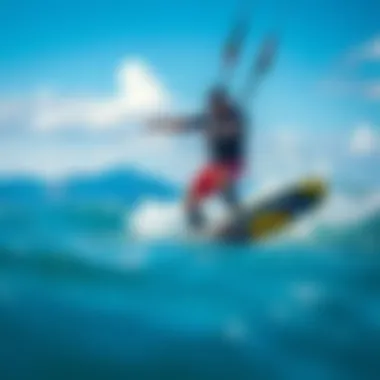
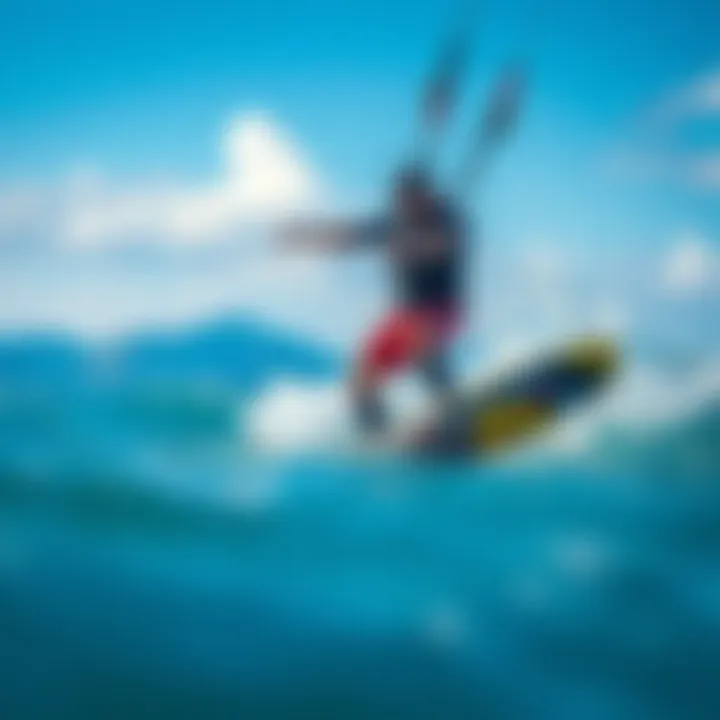
Gloves in kiteboarding serve a crucial function, providing not just protection but enhancing the overall experience on the water. Whether one is a seasoned professional or a weekend warrior, having the right gloves can make or break a session. Strong winds, water splashes, and the constant grip of the control bar call for gloves that offer wear resistance, comfort, and utility. Without suitable gloves, kiteboarders may find themselves battling the elements with less confidence and greater risks.
Functionality of Gloves
Kiteboarding gloves are more than just a fashion statement. Their primary functionality revolves around safeguarding the hands from harsh elements. First and foremost, these gloves can prevent blisters, a common concern whenever hands are exposed to repetitive friction over long periods. Additionally, they provide insulation against cold water, which can quickly sap a rider’s energy and enjoyment. Furthermore, gloves improve grip on the control bar making it easier to maneuver under various conditions.
Material Choices for Gloves
Neoprene Gloves
Neoprene gloves are a favorite among kiteboarders for good reason. The incredible flexibility they offer allows hands to move freely while still being shielded from the cold. One of the standout characteristics is their insulating properties, maintaining warmth even in legacy conditions. They also fit snugly, flexible enough to handle equipment adjustments without compromising grip. Neoprene’s water resistance means the gloves don’t become heavy when wet, keeping the performance consistent. However, they can sometimes be a bit costly for those on a tighter budget.
Mesh and Other Fabrics
On the other hand, mesh and lighter fabrics have gained traction for their breathability. Unlike neoprene, they don’t trap heat, making them an excellent choice for warmer climates. The key characteristic is their lightweight nature which allows for exceptional mobility. However, they aren't as durable as neoprene gloves and may not hold up as well in rough waters. The situation can be a tricky balance between comfort and longevity, but in the right environments, they provide unique advantages.
Different Styles of Gloves
Full-Finger Gloves
Full-finger gloves cover every inch of the hands, offering maximum protection. This style is particularly beneficial in cooler climates or when dealing with rough surf conditions. Their snug fit ensures that warmth is efficiently trapped while shielding skin from scrapes and abrasions. However, some kiteboarders feel this style could limit finger dexterity when making tiny adjustments.
Half-Finger Gloves
Ideal for those warm, sunny days, half-finger gloves offer less coverage. Riders who value feel and sensitivity often opt for these, as they allow for better grip and tactile feedback on the bar. However, they come with the trade-off of lesser protection, which could be a dealbreaker for those frequently in rough waters.
Gaiter Gloves
Gaiter gloves are quite unique because they often come with an extended cuff, which not only protects the hands but also offers wrist support. This makes them a smart choice for individuals who may be prone to wrist injuries or those looking for extra stability on the water. The downside? They can sometimes feel bulkier than standard gloves, which might deter those who prioritize a feather-light feel.
Choosing the Right Size
Finding the correct size in gloves is paramount for comfort and function. A too-tight pair can stifle circulation, while overly loose gloves can lead to a lack of control over the bar. Measure hand circumference and refer to the brand's sizing chart to make an informed choice. Trying on gloves before purchasing, if possible, is always a good practice to ensure they fit snugly but comfortable.
"The right gear can feel like an extension of yourself on the water. Don't settle for anything less than a perfect fit."
Safety Considerations
Diving into the essence of kiteboarding, safety emerges as a crucial factor that can dictate the difference between an exhilarating ride and a harrowing experience. Accessories like swimming booties and gloves contribute significantly to ensuring a safer kiteboarding adventure. These elements not only serve functional purposes but also provide a level of protection that every kiteboarder, from novice to expert, needs to prioritize.
When kiteboarding, the open waters present numerous risks. The unpredictability of the ocean, coupled with the potential for sharp objects—be it reefs, shells, or bits of debris—can lead to injuries. This is where swimming booties play their part, providing a buffer against harsh underwater terrains and even offering insulation against chilly waters. On the flip side, gloves help maintain control over the kite, allowing for a firmer grip. This control is particularly necessary when conditions turn rough or turbulent.
What’s worth noting is that every kiter should embrace these accessories not just for comfort but as fundamental safety tools. Without the right gear, one might find themselves in an unfortunate predicament that could have easily been avoided. Let’s dissect the specific benefits these accessories offer—each piece is designed with intention, keeping safety at the forefront.
Protective Benefits of Booties
Swimming booties, crafted from resilient materials like neoprene, provide substantial protection for the feet. Not only do they cushion impacts from hard surfaces, but they also shield against cuts and abrasions. This ability to safeguard feet is not to be underestimated, especially when venturing into less familiar waters where hidden dangers lurk just below the surface.
Some advantages include:
- Thermal insulation: Keeping your feet warm in cool water helps in maintaining overall body temperature.
- Non-slip soles: Many booties feature textured bottoms, aiding in grip, whether on the board or the sand.
- Fluid resistance: Quality booties minimize water intrusion, ensuring your feet remain dry and comfortable.
It’s essential, however, to select booties that fit snugly without being overly tight. Ill-fitting booties can lead to blisters or irritation, turning an enjoyable kiteboarding session into a painful misadventure.
"Comfort is key, but protection should never be an afterthought."
Gloves as a Safety Tool
Equipping the hands with gloves may seem like a trivial choice at first, but their importance cannot be overstated. In kiteboarding, where control, dexterity, and grip are paramount, gloves serve as an extension of your body. They enhance your ability to manage the equipment more effectively, particularly during high winds and extreme maneuvers.
Key aspects of gloves include:
- Enhanced grip: The right gloves improve traction on the bar, ensuring that hands don’t slip during pivotal moments. This holds especially true when navigating choppy waters.
- Protection from elements: Gloves protect hands from cold temperatures and harsh sunlight, which can lead to fatigue and decrease performance.
- Durability against wear: High-quality materials in gloves are designed to withstand the rigors of kiteboarding, reducing the risk of tears and punctures that could expose skin to injuries.
The choice of glove style—be it full-finger, half-finger, or gaiter—should hinge on the prevailing conditions and personal comfort. Ultimately, incorporating gloves into your kiteboarding kit serves as a safeguard, allowing for better handling and ultimately a safer experience.
Environmental Impact and Protection
In the world of kiteboarding, the right gear does more than just improve performance; it plays a pivotal role in ensuring environmental protection. As enthusiasts, it's vital to recognize that our enjoyment of the ocean and waterways comes with the responsibility to protect them. Understanding how swimming booties and gloves contribute not only to personal safety but also to the well-being of marine ecosystems is essential for every kiteboarder.
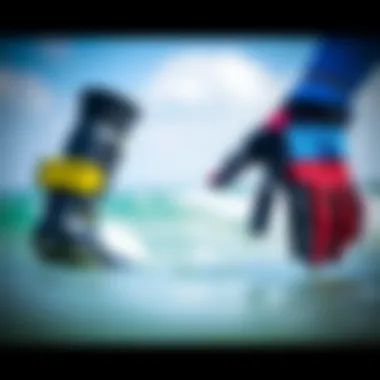
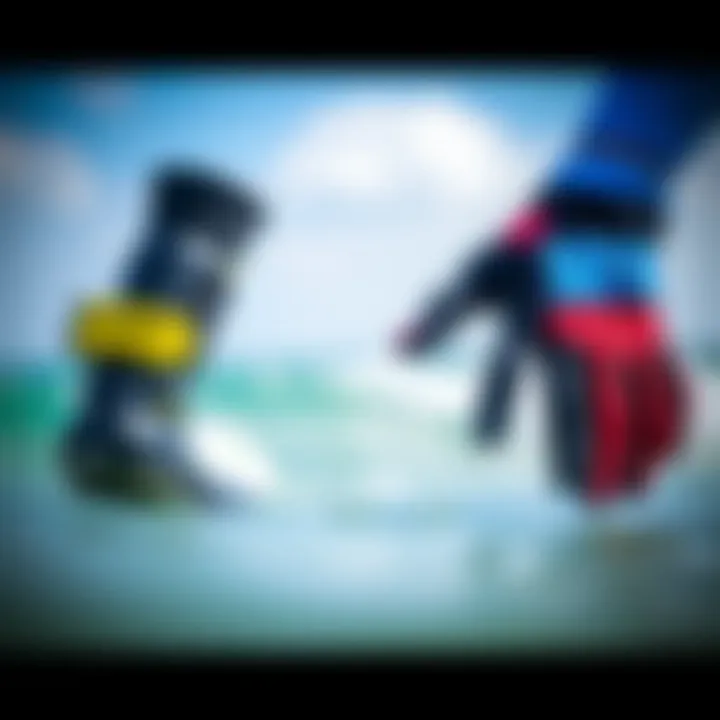
Protecting Feet from Marine Life
One of the most immediate concerns for kiteboarders venturing into the water is the unseen life that lies beneath the surface. Sharp shells, jagged rocks, and even the occasional sting from a jellyfish can turn a perfect day on the waves into a painful nightmare. A good pair of swimming booties acts as a shield for your feet, providing a barrier between you and these potential hazards.
Booties made from durable materials such as neoprene allow for flexibility while maintaining a protective layer against cuts and stings. They often come with textured soles that enhance grip on slippery surfaces, making them not just a shield but a security feature, too. The extra traction can prevent slips when launching or landing your board, reducing the chance of accidents. Furthermore, protecting your feet means you're less likely to disrupt marine life while treading lightly in the water. Whether you're paddling out or taking a break on the beach, booties help you navigate unknown terrains without causing unintentional harm to any creatures that might be lurking.
Weather Protection with Gloves and Booties
Kiteboarding often places you at the mercy of the elements. Wind, sun, and water can be refreshing, but they also pose their own challenges. This is where gloves and booties come into the environmental equation once again. On chilly days, gloves not only keep your hands warm but also provide a level of protection against the sun's harsh UV rays.
Booties serve a similar dual purpose. When the water is crisp, they keep your feet warm, allowing for extended sessions without the numbing chill that can sap your energy and joy. A good wet-suit-style booty can insulate against cold temperatures while still allowing for that essential connection to your board. This connection is invaluable; it improves your control and responsiveness to the water conditions, making your riding experience more enjoyable. Moreover, protecting your hands and feet can drastically reduce fatigue, allowing you to focus on enjoying every moment out on the water.
In essence, choosing quality swimming booties and gloves can significantly amplify your kiteboarding adventure while also serving as vital elements in minimizing your environmental footprint.
By investing in these protective accessories, kiteboarders can engage responsibly with nature. It allows us not only to experience the thrilling ride of a lifetime but also to contribute positively to the natural beauty that supports our beloved sport, ensuring it flourishes for generations to come. In doing so, we play our part in keeping our ocean ecosystems vibrant and healthy.
Performance Enhancement
When it comes to kiteboarding, the right accessories can make or break your experience on the water. Performance enhancement through swimming booties and gloves is an often overlooked aspect but holds significant importance. Beyond just comfort, these accessories provide crucial support in various ways that can enhance one's kiteboarding performance.
Improved Grip with Gloves
A solid grip is vital for kiteboarders. Gloves play a fundamental role here, offering texture and grip to help control the kite and board with precision. The material and design of a glove can determine how well a rider can hold onto the bar, especially in challenging conditions like gusty winds or waves. Most gloves are designed with textured surfaces, which increase friction between gloves and bar. This also helps to reduce hand fatigue, allowing riders to maintain control for longer consecutive sessions.
Additionally, the right fit matters. A glove that hugs the hand too tightly might hinder blood circulation, while a loose glove can slip and reduce sensitivity. Therefore, choosing gloves that fit snugly without being constrictive is paramount. You can often test different styles at local sporting goods stores or during demo days, ensuring a glove that's just right for you.
To sum it up, gloves aren’t just about keeping warm; they’re about establishing a strong connection between the rider and their gear, empowering them to react flawlessly to the dynamics of the water.
Stability and Control from Booties
Stability in kiteboarding can often make the difference between a successful run and a spill into the water. Swimming booties contribute to this stability by providing a secure footing on the board. The sole of a good bootie should offer grip without sacrificing flexibility. This allows for rapid adjustments to stance and balance, which is crucial when navigating through unpredictable waters.
A well-designed bootie will generally conform closely to the foot's shape, minimizing unnecessary movement inside the boot. This snug fit helps maintain a constant feeling of connection to the board, ensuring that the rider can quickly shift their weight as needed for stability. Importantly, some designs include reinforced soles to protect the feet, especially during tough landings or when walking on rocky beaches.
Moreover, unfurling and molding to the foot’s shape allows for better performance over time. With repeated use, these booties adapt significantly, leading to comfort and a connection with the board that enhances overall performance.
Care and Maintenance of Gear
Taking care of your gear is just as crucial as selecting the right equipment when kiteboarding. Proper maintenance not only prolongs the life of your swimming booties and gloves but also ensures they perform at peak levels when you're out on the water. The uncomfortable truth is, neglecting care can lead to swift deterioration, rendering even the most expensive gear ineffective. Keeping your accessories in good shape means you’ll remain safe while enjoying the thrilling experience of kiteboarding.
Cleaning Tips for Booties
Swimming booties go through a lot. Every time you step onto the water, they're exposed to salt, sand, and all sorts of marine life. Thus, cleaning them correctly can make all the difference. Here’s how:
- Rinse Immediately: After each session, give your booties a good rinse with fresh water. This flushe out any salt and sand that might stick.
- Use Mild Soap: Every now and then, use a gentle soap to scrub them. Avoid bleach or harsh detergents, as they can break down the materials.
- Dry Properly: Air-dry your booties in a shaded area to prevent UV damage. Avoid direct sunlight, as it can warp or crack the material. If possible, try to turn them inside out to dry the inner lining as well.
- Store Wisely: When it’s time to hang up your gear, make sure your booties are stored flat or hung, avoiding creases.
By developing these cleaning habits, your booties will not only look good but will also be ready to tackle whatever the ocean throws at you.
Maintaining the Longevity of Gloves
Gloves might seem straightforward, but they have their own quirks when it comes to care. Here are key practices you need to keep in mind:
- Frequent Inspection: Check your gloves regularly. Look for signs of wear like small tears or pooling of water. Catching these issues early can be the difference between a minor fix and needing a new pair.
- Wash Carefully: Some gloves can handle machine washing on a gentle cycle, but others might need a hand wash with lukewarm water and mild soap. Always follow the manufacturer’s care instructions.
- Air Out After Use: Like your booties, give your gloves some fresh air after each outing. This prevents any funk from building up and keeps your hands comfortable for next session.
- Avoid Long Exposure to Sun: Just as UV rays can harm your booties, they can wear down glove materials too. Store them in a cool dark place.
With attentive care, your gloves can remain a reliable companion through each thrilling kiteboarding experience.
"Investing time in maintaining your gear pays off tenfold during those intense sessions on the water."
For more insights on gear care and maintenance, check out resources from Wikipedia, or forums on Reddit.
Closure: Strategic Gear Choices for Success
When it comes to kiteboarding, selecting the right equipment is not merely a personal preference; it can significantly impact your overall enjoyment and performance. Choosing the right swimming booties and gloves allows you to navigate through different water conditions with confidence and comfort. In a sport that combines thrilling speeds and unpredictable elements, having gear that protects while enhancing your abilities is essential.
Reflecting on Personal Preferences
Every kiteboarder has unique preferences that stem from individual experiences, body types, and personal style. Some riders might prefer thicker booties for more warmth, especially in colder waters, while others might prioritize flexibility and go for thinner materials. Similarly, the choice of gloves can vary greatly. For those who value dexterity, half-finger gloves might be the go-to option, providing a perfect blend of grip and the ability to feel the lines without losing too much warmth.
In considering your gear, think about where and when you plan to ride. Do you often find yourself in shallow waters or rocky beaches? That may influence your choice to prioritize sturdier, more protective foot gear. Conversely, if you prefer consistent weather and warmer waters, you might not need as much insulation. Exploring these preferences helps in narrowing down choices, ensuring that you feel at ease while kitesurfing.
Final Thoughts on Performance and Safety
The ultimate goal of investing in quality gloves and swimming booties is to enhance your experience on the water while ensuring your safety. High-grade gear can prevent injuries caused by sharp objects or marine life, as well as give you the grip needed to maneuver effectively and securely. Not only do these accessories serve necessary functional purposes, but they also contribute to your confidence in different riding conditions. Knowing you’re prepared allows you to push your limits, whether you are chasing the wind or catching the waves.
Ultimately, the right strategic gear choices—tailored to your unique needs—can make all the difference in how you experience kiteboarding. With an understanding that your comfort impacts performance, investing in good-quality gear is not just a choice but a necessity for anyone serious about this exhilarating sport. As conditions change, so too must our approach to gear, leading to a safer and much more enjoyable adventure on the water.



